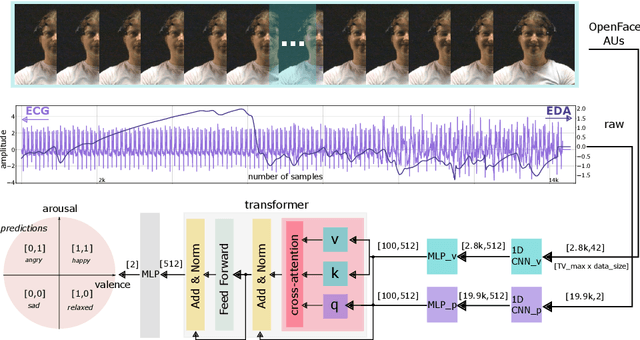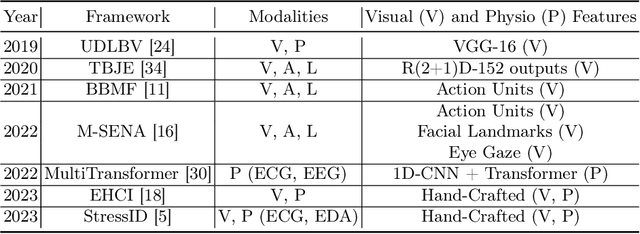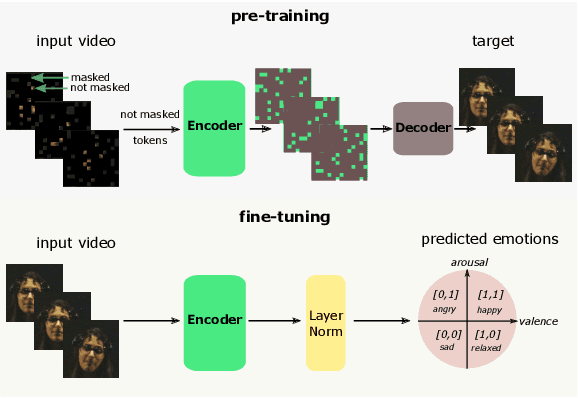facial recognition
Facial recognition is an AI-based technique for identifying or confirming an individual's identity using their face. It maps facial features from an image or video and then compares the information with a collection of known faces to find a match.
Papers and Code
Driver Assistance System Based on Multimodal Data Hazard Detection
Feb 05, 2025



Autonomous driving technology has advanced significantly, yet detecting driving anomalies remains a major challenge due to the long-tailed distribution of driving events. Existing methods primarily rely on single-modal road condition video data, which limits their ability to capture rare and unpredictable driving incidents. This paper proposes a multimodal driver assistance detection system that integrates road condition video, driver facial video, and audio data to enhance incident recognition accuracy. Our model employs an attention-based intermediate fusion strategy, enabling end-to-end learning without separate feature extraction. To support this approach, we develop a new three-modality dataset using a driving simulator. Experimental results demonstrate that our method effectively captures cross-modal correlations, reducing misjudgments and improving driving safety.
Two-Stream Spatial-Temporal Transformer Framework for Person Identification via Natural Conversational Keypoints
Feb 28, 2025



In the age of AI-driven generative technologies, traditional biometric recognition systems face unprecedented challenges, particularly from sophisticated deepfake and face reenactment techniques. In this study, we propose a Two-Stream Spatial-Temporal Transformer Framework for person identification using upper body keypoints visible during online conversations, which we term conversational keypoints. Our framework processes both spatial relationships between keypoints and their temporal evolution through two specialized branches: a Spatial Transformer (STR) that learns distinctive structural patterns in keypoint configurations, and a Temporal Transformer (TTR) that captures sequential motion patterns. Using the state-of-the-art Sapiens pose estimator, we extract 133 keypoints (based on COCO-WholeBody format) representing facial features, head pose, and hand positions. The framework was evaluated on a dataset of 114 individuals engaged in natural conversations, achieving recognition accuracies of 80.12% for the spatial stream, 63.61% for the temporal stream. We then explored two fusion strategies: a shared loss function approach achieving 82.22% accuracy, and a feature-level fusion method that concatenates feature maps from both streams, significantly improving performance to 94.86%. By jointly modeling both static anatomical relationships and dynamic movement patterns, our approach learns comprehensive identity signatures that are more robust to spoofing than traditional appearance-based methods.
FRIDAY: Mitigating Unintentional Facial Identity in Deepfake Detectors Guided by Facial Recognizers
Dec 19, 2024Previous Deepfake detection methods perform well within their training domains, but their effectiveness diminishes significantly with new synthesis techniques. Recent studies have revealed that detection models often create decision boundaries based on facial identity rather than synthetic artifacts, resulting in poor performance on cross-domain datasets. To address this limitation, we propose Facial Recognition Identity Attenuation (FRIDAY), a novel training method that mitigates facial identity influence using a face recognizer. Specifically, we first train a face recognizer using the same backbone as the Deepfake detector. The recognizer is then frozen and employed during the detector's training to reduce facial identity information. This is achieved by feeding input images into both the recognizer and the detector, and minimizing the similarity of their feature embeddings through our Facial Identity Attenuating loss. This process encourages the detector to generate embeddings distinct from the recognizer, effectively reducing the impact of facial identity. Extensive experiments demonstrate that our approach significantly enhances detection performance on both in-domain and cross-domain datasets.
Facial Expression Recognition with Controlled Privacy Preservation and Feature Compensation
Dec 03, 2024



Facial expression recognition (FER) systems raise significant privacy concerns due to the potential exposure of sensitive identity information. This paper presents a study on removing identity information while preserving FER capabilities. Drawing on the observation that low-frequency components predominantly contain identity information and high-frequency components capture expression, we propose a novel two-stream framework that applies privacy enhancement to each component separately. We introduce a controlled privacy enhancement mechanism to optimize performance and a feature compensator to enhance task-relevant features without compromising privacy. Furthermore, we propose a novel privacy-utility trade-off, providing a quantifiable measure of privacy preservation efficacy in closed-set FER tasks. Extensive experiments on the benchmark CREMA-D dataset demonstrate that our framework achieves 78.84% recognition accuracy with a privacy (facial identity) leakage ratio of only 2.01%, highlighting its potential for secure and reliable video-based FER applications.
NullSwap: Proactive Identity Cloaking Against Deepfake Face Swapping
Mar 24, 2025Suffering from performance bottlenecks in passively detecting high-quality Deepfake images due to the advancement of generative models, proactive perturbations offer a promising approach to disabling Deepfake manipulations by inserting signals into benign images. However, existing proactive perturbation approaches remain unsatisfactory in several aspects: 1) visual degradation due to direct element-wise addition; 2) limited effectiveness against face swapping manipulation; 3) unavoidable reliance on white- and grey-box settings to involve generative models during training. In this study, we analyze the essence of Deepfake face swapping and argue the necessity of protecting source identities rather than target images, and we propose NullSwap, a novel proactive defense approach that cloaks source image identities and nullifies face swapping under a pure black-box scenario. We design an Identity Extraction module to obtain facial identity features from the source image, while a Perturbation Block is then devised to generate identity-guided perturbations accordingly. Meanwhile, a Feature Block extracts shallow-level image features, which are then fused with the perturbation in the Cloaking Block for image reconstruction. Furthermore, to ensure adaptability across different identity extractors in face swapping algorithms, we propose Dynamic Loss Weighting to adaptively balance identity losses. Experiments demonstrate the outstanding ability of our approach to fool various identity recognition models, outperforming state-of-the-art proactive perturbations in preventing face swapping models from generating images with correct source identities.
DIPSER: A Dataset for In-Person Student1 Engagement Recognition in the Wild
Feb 27, 2025In this paper, a novel dataset is introduced, designed to assess student attention within in-person classroom settings. This dataset encompasses RGB camera data, featuring multiple cameras per student to capture both posture and facial expressions, in addition to smartwatch sensor data for each individual. This dataset allows machine learning algorithms to be trained to predict attention and correlate it with emotion. A comprehensive suite of attention and emotion labels for each student is provided, generated through self-reporting as well as evaluations by four different experts. Our dataset uniquely combines facial and environmental camera data, smartwatch metrics, and includes underrepresented ethnicities in similar datasets, all within in-the-wild, in-person settings, making it the most comprehensive dataset of its kind currently available. The dataset presented offers an extensive and diverse collection of data pertaining to student interactions across different educational contexts, augmented with additional metadata from other tools. This initiative addresses existing deficiencies by offering a valuable resource for the analysis of student attention and emotion in face-to-face lessons.
BIG-MoE: Bypass Isolated Gating MoE for Generalized Multimodal Face Anti-Spoofing
Dec 24, 2024In the domain of facial recognition security, multimodal Face Anti-Spoofing (FAS) is essential for countering presentation attacks. However, existing technologies encounter challenges due to modality biases and imbalances, as well as domain shifts. Our research introduces a Mixture of Experts (MoE) model to address these issues effectively. We identified three limitations in traditional MoE approaches to multimodal FAS: (1) Coarse-grained experts' inability to capture nuanced spoofing indicators; (2) Gated networks' susceptibility to input noise affecting decision-making; (3) MoE's sensitivity to prompt tokens leading to overfitting with conventional learning methods. To mitigate these, we propose the Bypass Isolated Gating MoE (BIG-MoE) framework, featuring: (1) Fine-grained experts for enhanced detection of subtle spoofing cues; (2) An isolation gating mechanism to counteract input noise; (3) A novel differential convolutional prompt bypass enriching the gating network with critical local features, thereby improving perceptual capabilities. Extensive experiments on four benchmark datasets demonstrate significant generalization performance improvement in multimodal FAS task. The code is released at https://github.com/murInJ/BIG-MoE.
MVP: Multimodal Emotion Recognition based on Video and Physiological Signals
Jan 06, 2025



Human emotions entail a complex set of behavioral, physiological and cognitive changes. Current state-of-the-art models fuse the behavioral and physiological components using classic machine learning, rather than recent deep learning techniques. We propose to fill this gap, designing the Multimodal for Video and Physio (MVP) architecture, streamlined to fuse video and physiological signals. Differently then others approaches, MVP exploits the benefits of attention to enable the use of long input sequences (1-2 minutes). We have studied video and physiological backbones for inputting long sequences and evaluated our method with respect to the state-of-the-art. Our results show that MVP outperforms former methods for emotion recognition based on facial videos, EDA, and ECG/PPG.
Novel AI Camera Camouflage: Face Cloaking Without Full Disguise
Dec 18, 2024



This study demonstrates a novel approach to facial camouflage that combines targeted cosmetic perturbations and alpha transparency layer manipulation to evade modern facial recognition systems. Unlike previous methods -- such as CV dazzle, adversarial patches, and theatrical disguises -- this work achieves effective obfuscation through subtle modifications to key-point regions, particularly the brow, nose bridge, and jawline. Empirical testing with Haar cascade classifiers and commercial systems like BetaFaceAPI and Microsoft Bing Visual Search reveals that vertical perturbations near dense facial key points significantly disrupt detection without relying on overt disguises. Additionally, leveraging alpha transparency attacks in PNG images creates a dual-layer effect: faces remain visible to human observers but disappear in machine-readable RGB layers, rendering them unidentifiable during reverse image searches. The results highlight the potential for creating scalable, low-visibility facial obfuscation strategies that balance effectiveness and subtlety, opening pathways for defeating surveillance while maintaining plausible anonymity.
M2SE: A Multistage Multitask Instruction Tuning Strategy for Unified Sentiment and Emotion Analysis
Dec 11, 2024



Sentiment analysis and emotion recognition are crucial for applications such as human-computer interaction and depression detection. Traditional unimodal methods often fail to capture the complexity of emotional expressions due to conflicting signals from different modalities. Current Multimodal Large Language Models (MLLMs) also face challenges in detecting subtle facial expressions and addressing a wide range of emotion-related tasks. To tackle these issues, we propose M2SE, a Multistage Multitask Sentiment and Emotion Instruction Tuning Strategy for general-purpose MLLMs. It employs a combined approach to train models on tasks such as multimodal sentiment analysis, emotion recognition, facial expression recognition, emotion reason inference, and emotion cause-pair extraction. We also introduce the Emotion Multitask dataset (EMT), a custom dataset that supports these five tasks. Our model, Emotion Universe (EmoVerse), is built on a basic MLLM framework without modifications, yet it achieves substantial improvements across these tasks when trained with the M2SE strategy. Extensive experiments demonstrate that EmoVerse outperforms existing methods, achieving state-of-the-art results in sentiment and emotion tasks. These results highlight the effectiveness of M2SE in enhancing multimodal emotion perception. The dataset and code are available at https://github.com/xiaoyaoxinyi/M2SE.
 Add to Chrome
Add to Chrome Add to Firefox
Add to Firefox Add to Edge
Add to Edge